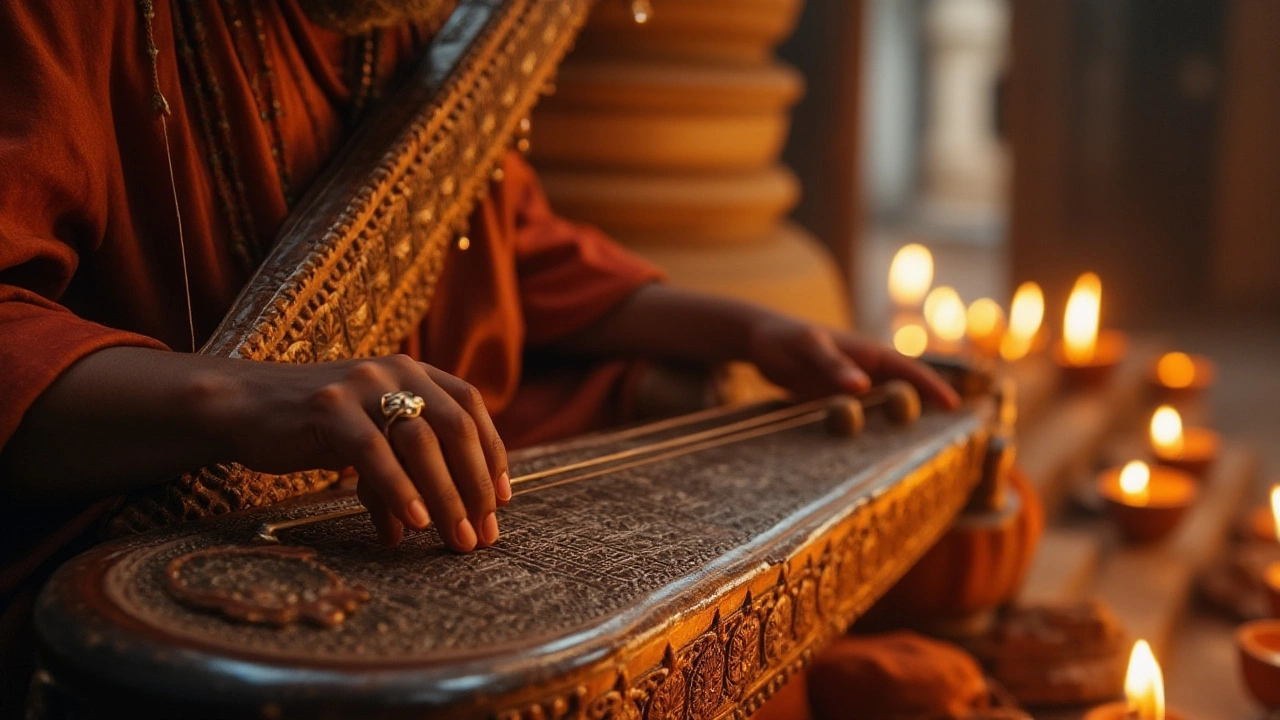The notion of expressing farewell through music is as ancient as human emotion itself. Funeral songs, the melodies of parting, hold a unique place in our history, bridging generations and cultures. This exploration delves into the depths of time to unearth the oldest known funeral song, revealing its enduring influence on human expression.
In ancient civilizations, these songs were woven into the fabric of farewell rituals, guiding souls into the afterlife with a symphony of sacred sounds. By understanding the origins and evolution of funeral music, we gain a deeper appreciation not just for the songs themselves but for the human experiences they encapsulate.
- The Origins of Funeral Music
- Ancient Instruments and Melodies
- Cultural Significance and Rituals
- The Evolution of Funeral Songs
The Origins of Funeral Music
Tracing the roots of funeral song is akin to unraveling the intricate tapestry of human emotions and cultural traditions. From the ancient Sumerians to the Egyptians, and even the Greeks, mourning through music has been a universal experience, serving as both a personal and communal expression of grief. The Sumerians, one of the earliest known civilizations, left behind cuneiform tablets that depict the use of the lyre and lyre-like instruments in funerary contexts. The songs played were believed to beckon the gods, providing solace to the grieving families while ensuring safe passage for the departed souls.
In Ancient Egypt, music was intrinsic to the funerary process and was often linked with the divine. Tomb paintings show musicians, often female, playing harps and singing to honor the gods and the dead. The Egyptians' belief in the afterlife underscored their use of music in funeral rites, considering it a bridge between the earthly realm and the beyond. This would not only console the living but also comfort the ka, the spirit of the deceased. The power of music was such that it was seen as essential to guide the soul.
Moving to Ancient Greece, music had a profound place in funerary rituals. The Greeks believed that music had moral and ethical value; hence, a well-composed dirge was necessary for a respectful send-off. Poems like those by Homer, including lamentations, were sung during funeral processions to ease the passage of souls into the afterlife. These melodies often utilized minor scales to evoke the right mix of somberness and beauty, leaving a lasting influence on western music traditions. A notable quote by ancient historian Herodotus says,
"Music brings forth the nobility in pain and prolongs the memory of valor."
Influence of Ancient Instruments
The instruments that accompanied these songs tell their tales of ingenuity and adaptation. Each civilization crafted its instruments to suit the timbre and tone they sought to achieve. The lyre from Sumeria, the harp from Egypt, and the aulos or double reed pipe from Greece showcase early innovation. Playing techniques were often passed down through generations orally, along with the songs, creating a long-standing tradition. Such music, though ancient, laid the groundwork for contemporary expressions of grief.
These ancient songs underscore the intrinsic human need to articulate loss and honor life. The harmony found in these old tunes is not merely in the sound, but in the shared human experiences they represent, illustrating how in death, we often find a deeper connection to life itself. By exploring these ancient melodies, we uncover the universal language of music.

Ancient Instruments and Melodies
When we peer back through the misty corridors of time, we discover the profound resonance of ancient music, deeply entwined with humanity's earliest expressions of grief. Our journey through the oldest funeral song takes us to civilizations where the boundaries of music and spirituality blurred into a harmonious blend, resonating with the rhythms of life and death. The ancient Egyptians, for instance, played a significant role in crafting funeral music, using ancient instruments that might seem rudimentary by today's standards yet held an emotional depth that modern replicas strive to emulate. The oud, a lute-like instrument, was revered in many Mesopotamian practices, setting the tone for ceremonial farewells. Its pear-shaped body and fretless neck allowed for a vast range of haunting melodies, evolving into what some have deemed a precursor to the guitar.
Mesopotamians were not only innovators in agriculture and architecture but also in music. They introduced the ancient world to the lyre, a harp-like instrument whose strings were plucked to provide a musical canvas for the poetic dirges that marked the transition between worlds. Such instruments were found meticulously detailed on the walls of Assyrian palaces, painting a picture of their importance in cultural rituals. Interestingly, archaeologists uncovered one of the oldest examples of sheet music on a cuneiform tablet in Ugarit, Syria. This ancient piece, dated over 3,400 years old, offered insights into how these people might have sung their songs of mourning, integrating the lyre’s distinct, ethereal sound.
In ancient Greece, funeral music was essential, with the oldest song often linked to the epitaphios, a form of lamentation hymn sung by mourning relatives. Accompanied typically by the aulos, a double-reeded wind instrument, it provided melodies that underscored the deep sense of loss. As Aristotle once suggested, "Poetry is the music of the soul, and above all, of great and feeling souls." The ancient Greeks harnessed this belief, crafting melodies that etched their ways into the hearts of those left behind.
"Music is a higher revelation than all wisdom and philosophy." This sentiment by Ludwig van Beethoven echoes through the ages, suggesting the eternal nature of music as a vessel for emotion. It underscores the notion that these ancient melodies were much more than mere songs; they were a profound articulation of the human experience.
These oldest funeral songs were not merely artistic expressions but integral parts of rituals meant to ease the transition to the afterlife. The use of music in such occasions was less about performance and more about invoking emotion, connecting the living with the dead in a sacred communication channel. This deep-seated tradition continues to inspire contemporary musicians, who often look back to these early templates of song to draw inspiration in expressing both personal and collective loss today. So, the legacy of ancient melodies and their instruments not only provided comfort and solace to ancient societies but also planted the seeds for the therapeutic uses of music in our modern age, reminding us of the timeless harmony between sound and sentiment.

Cultural Significance and Rituals
The thread of music weaves its way through the tapestry of human culture, acting as a vessel for expressing the inexpressible. In the realm of funeral songs, this expression becomes particularly poignant. Across cultures and epochs, melodies crafted for mourning have not only provided solace to the grieving but also facilitated the delicate transition of the departed to the realms beyond. The cultural implications of these songs are profound, influencing both individual emotions and societal practices. In many ancient cultures, such as those of the Egyptians and Mesopotamians, funeral music was integral to the rites accompanying the dead. These cultures believed that music helped bridge the gap between the living and the divine, guiding the spirit safely to the afterlife.
Various civilizations have developed distinct musical traditions to honor their deceased. In ancient Greece, the dirge was consequential, serving both as a lamentation and a vehicle of veneration. This tradition encased both the music and lyrics in a formalized structure that conveyed communal grief. The dichotomy of personal mourning and public spectacle highlighted the Greeks' understanding of death as both a private sorrow and a public affair. The Romans were known for their elaborate funerary processions where hired mourners and musicians played a significant role. They marked the importance of the deceased with the grandeur of these ceremonies, reflecting on the individual's life and societal contributions through elaborate music and song.
In China, ancient funerary songs often included bells and flutes to create serene and ethereal sounds—believed to have the power to communicate with heavenly spirits. Confucian ideology emphasized music as a force for spiritual guidance and social harmony, positioning it as integral to the rituals of death. This ideology has permeated through the ages, showing its enduring impact even as musical styles evolved. Each culture's approach to funeral music hinged on their beliefs about death and the afterlife, illustrating how universal the theme of ancient music was yet highlighting the diversity in execution.
The role of music in funerary rituals often provided comfort, serving as a reminder of the believer's spiritual path after life on earth. The evocative power of these songs lies not just in their melodies but in their timeless messages. As the Irish harpist Turlough O'Carolan poignantly described, "The music of the dead reaches beyond the grave to soothe the souls of the living."
Historian Paul Deane notes, "Funeral music functions as a ritualistic language bridging the silence of death with the sounds of remembrance." These songs have continued to echo through time because they tap into our most primal emotions—our desire for connection and understanding amidst loss.
Cultures around the world have adopted and adapted musical traditions, leading to a rich tapestry of rituals that persists to this day. Understandably, people across different historical backgrounds have turned to oldest song forms and funeral music to fulfill a universal need—navigating the experience of grief while celebrating the life that was lived. These melodies stand as cultural artifacts that speak deeply to human resilience and the undying transmission of wisdom from death to life.

The Evolution of Funeral Songs
Throughout history, funeral songs have undergone a transformation as they adapted to the cultural, religious, and social influences of each era. The journey of these solemn melodies is a window into how humanity has chosen to honor and commemorate the deceased. We see ancient communities where songs served to both mourn the loss and celebrate the life of the departed, with contemporary music inheriting much from these traditions. In the early times, the function of these songs was more than merely ceremonial; they were believed to facilitate the transition of the soul into the afterlife, a common theme across various ancient cultures including the Egyptians, Greeks, and Mesopotamians. This was achieved through chants that echoed around tombs and temples, thought to please the gods and ensure a peaceful journey.
As centuries passed, recorded music evolved alongside our understanding of life and death. The medieval period marked a significant development with the introduction of religious hymns in Christian services, shaping the musical history of funerals in the Western world. These songs often drew inspiration from biblical texts, providing not just comfort but also a promise of eternal life to those who mourned. Composers like Johann Sebastian Bach and Wolfgang Amadeus Mozart included elaborate requiem masses that are performed to this day. Just as these influences were felt in Western traditions, so too were they mirrored globally. In Asia, for instance, Buddhist chants and Hindu hymns offered similar solace and guidance, portraying the universality of music as a balm for grief.
Entering the modern era, we witness an increasing diversity in funeral music. Given the broadening of cultural recognition and the acceptance of indigenous and local traditions, funeral songs have become an eclectic blend of styles and sounds. Gospel, jazz, and even rock have found their place in memorial services, reflecting the unique personalities of those being remembered. This trend highlights an important change - funerals are becoming more personalized, reflecting a life lived rather than a single facet of tradition. Dr. Alan Wolfelt, a respected grief counselor, once stated,
"Music at a funeral is a powerful way to honor the life lived and transform mourning into something positive."As preferences shift, we find songs like Eric Clapton's "Tears in Heaven" or Israel Kamakawiwo'ole's rendition of "Somewhere Over the Rainbow" offering comfort in contemporary funeral settings.
Interestingly, data from the National Funeral Directors Association shows a marked increase in eclectic choice of music over a decade, with nearly 60% of families choosing non-traditional songs at memorial services in the last five years. This statistic underscores the evolution of our relationship with grief through music. Funeral homes have adapted by expanding their digital music libraries, allowing families greater freedom in choosing pieces that speak to their individual narratives. This shift not only broadens our appreciation of music's role in mourning but underscores the human need to find meaning and connection through art as we say goodbye.





